Britain’s Biggest Alcohol Brands is The Grocer’s annual ranking of the biggest booze brands in the UK by value and volume.
Read our full analysis of what the year has brought for the off-trade alcohol sector here.
This ranking is part of Britain’s Biggest Alcohol Brands 2025. See what the top 100 brands have to say about their performance over the past year
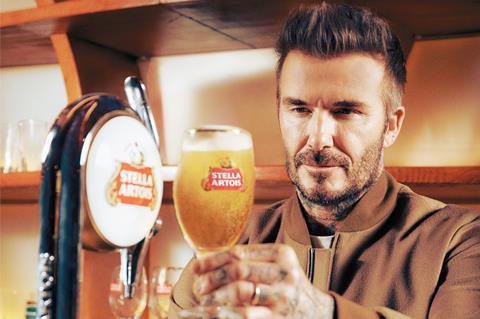
1 (1)
Stella Artois
Sales: £709.4m
Growth: –2.6%
Grocery’s biggest booze brand has picked a winner in David Beckham. He’s the face of its ‘Worth More’ campaign, which kicked off in March 2024.
Not only is Beckham one of the most well-known footballers of all time and the husband of a Spice Girl, he’s now Sir David, having received a knighthood in the King’s birthday honours earlier this month.
He was recognised for his sporting career and services to charity. But the role of Stella Artois global brand ambassador is where he’s put in the hard work of late.
In February, a 30-second ad saw Beckham reunited with long-lost twin brother Other David, played by Matt Damon. It aired in the prime evening slot during the Super Bowl, reaching an estimated 130 million viewers in the US alone.
He’s been on UK telly too, of course, as part of Stella’s wide-ranging activities. As well as splashing out on airtime throughout the year, the brand unveiled a digital and billboard push in April with the tagline ‘Worth it’. It depicted punters in pursuit of pints navigating crowds in packed bars.
Then there’s ‘When it rains, we pour’ – in which Stella, as the official beer of Wimbledon 2025, has pledged to hand out thousands of free pints of lager whenever bad weather stops play on Centre Court.
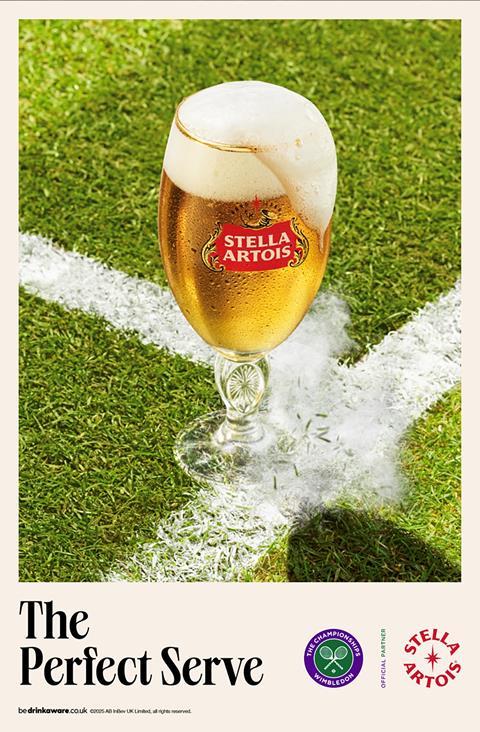
The brand’s UK brewer and distributor, Budweiser Brewing Group (BBG), could probably do without the added expense given the state of Stella’s sales. The brand has fallen £18.9m and shifted 10.4 million fewer litres in the past year, reversing the 6.3% value and 0.6% volume gains reported last year.
Of the 26 beer brands in this ranking, Stella’s value decline is the fourth biggest in absolute terms. Its alcohol-free lager, 0.0%, is the only product in its portfolio to have turned in any growth. It’s up 2.9% in value to £3.9m on volumes up 9.4%.
The brand’s core lager, on the other hand, is down 2.6% in value and 3.8% in volume. And Unfiltered, a key engine of growth since launch in 2022, has stalled. Value has slipped 2.8% to £32.8m and volumes are down 2.3% following distribution losses.
Not only is BBG selling less Stella, it’s also increasingly struggling to turn a profit. In its most recent accounts, the company declared a £72.1m loss, even though revenues had increased from £1.6bn to £1.7bn in the financial year to 31 December 2023. BBG has not made a pre-tax profit since 2020.
“Persistent inflation, driven by high energy and food costs, resulted in volatile input costs, supply chain disruptions and shifting consumer demand as households managed reduced disposable incomes,” wrote the company in a statement filed at Companies House.
“Despite some easing of inflation later in the year, economic uncertainty remained, necessitating agile supply management and strategic pricing adjustments.”
For Stella’s core lager, that’s resulted in a 1.2% rise in average price per litre. The trouble is, shoppers are still sensitive to such changes. “The beer and cider category has seen sales and penetration decline as households are still impacted by the cost of living crisis,” says Rob Hallworth, NIQ senior client insight partner.
“Promotions and price cuts have been key for brands to attract shoppers concerned about tight budgets,” he adds.
This helps explain why continental lager brands such as Kronenbourg 1664 (28) and Madrí Excepcional (33) have gained ground on the market leader. Average prices of both have fallen in the past year.
Another challenge for Stella is the growing number of competitors capitalising on the lower rate of duty for beers below 3.4% abv, introduced in August 2023.
Carlsberg (15), for example, has enjoyed its second consecutive year of growth, after cutting the abv of its core Pilsner from 3.8% to 3.4% in 2023. This helped the brand regain lost distribution and undercut its rivals.
BrewDog’s (20) 3.4% abv lager Cold Beer has also won significant share after its launch last summer. It’s already the brewer’s eighth bestseller with value sales of £6.2m.
All this gives some clues as to the potential next steps for Stella – which cut its core lager’s abv from 4.8% to 4.6% in 2020. “Manufacturers are likely to continue to reformulate beer brands based on their performance, but sustained growth isn’t guaranteed,” says Hallworth.
“The 3.4% abv space is led by bigger brands reformulating rather than new brands hitting a consumer need, but this will continue to evolve.”
The question is, will Stella become part of that space?
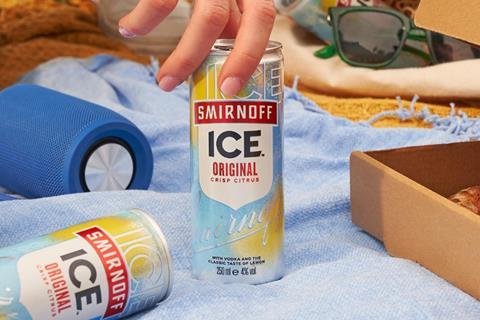
2 (2)
Smirnoff
Sales: £596.2m
Growth: –2.0%
Booze giant Diageo blames the Treasury for much of the difficulty facing Smirnoff. Britain’s biggest spirits brand has lost £11.9m and shifted 2.2 million fewer litres of its vodka, spirit drinks and RTDs.
Its spirits have declined 1.7% in value on volumes down 6.5%. No. 1, Cherry Drop, Raspberry Crush and Mango & Passionfruit Twist have all contributed to that decline.
“The spirits category has been challenging, largely driven by the impact of government policy, with excise duty on spirits rising 14% in less than two years,” says a spokesman. “This has driven up the price of spirits, alongside other major cost pressures, including new packaging regulations such as EPR.”
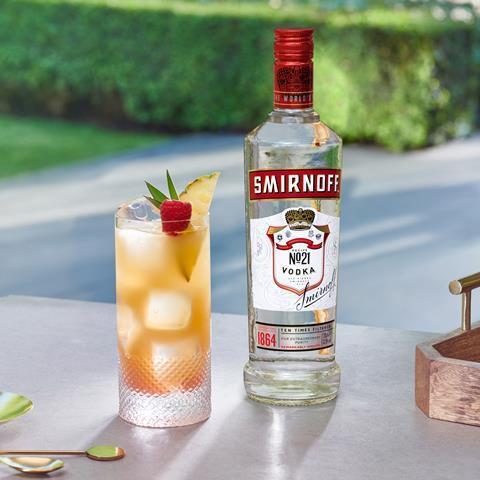
While it’s true to say spirits generally are in decline, the RTD sector has been more resilient. The performances of brands like Tanqueray (43), Au (58) and Funkin Cocktails (108) prove there’s still growth to be had in that market.
Smirnoff’s seen little of that, though. Its RTDs have fallen sharply – by 5.3% in value and 6.8% in volume. Smirnoff Ice has driven much of the decline.
There are bright spots, however, across the brand’s portfolio. Flavoured spirit drinks Spicy Tamarind (30% abv) and Miami Peach (35% abv) have racked up a combined £2m since their respective launches in early 2024 and early 2025. And the Miami Peach & Lemonade RTD hit nearly £100k in little over a month after its March 2025 debut.
“The RTD category is growing strongly, with over 500 sold every minute in the off-trade,” says the spokesman. “It’s been the fastest-growing impulse category in the past two years and has changed how Brits choose and drink our brands, particularly in places like festivals and outdoor venues.”
No wonder Diageo is investing in sampling at music festivals this summer, as well as a global push to mark the 25th anniversary or Smirnoff Ice.
3 (3)
Budweiser
Sales: £458.8m
Growth: –3.6%
Budweiser sales are down £17m and 3.2 million litres. The main culprit is the US brand’s core lager. The self-styled King of Beers has shed 8.4 million litres. It’s now worth £23.7m less, as Brits favour brews from other parts of the globe.
Bud Light, on the other hand, is soaring. Its value’s up 18% – completing its comeback from a downturn two years ago.
That was due to Brits drinking less at home and turning to more exotic beers when they did. (It coincided with a slump in the US, driven by a boycott of the brand, which had teamed up with trans influencer Dylan Mulvaney.)
Given the rising number of drinkers seeking lower-strength options, Bud Light’s 3.4% abv – compared to the 4.5% abv of regular Budweiser – makes it bang on-trend.
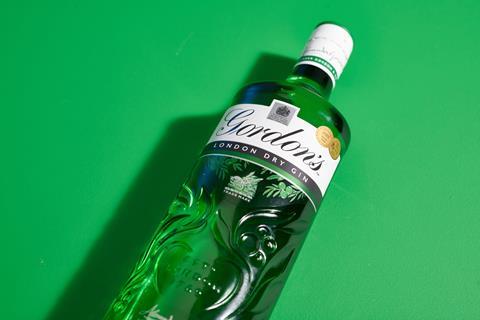
4 (4)
Gordon’s
Sales: £336.0m
Growth: –9.5%
Gordon’s has suffered the greatest absolute loss of any spirits brand in this year’s top 100. It’s sold 2.4 million fewer litres of gin and RTDs, sending value plummeting £35.2m.
The only products that have delivered meaningful growth are two alcohol-free RTDs. Together, Gin & Tonic 0.0 and Gin & Tonic Premium Pink 0.0 have racked up £2.5m. That’s a value gain of 18.3% and volume growth of 21.2%.
Their performance provides further evidence that Brits are drinking “better, not more”, says Gordon’s owner Diageo.
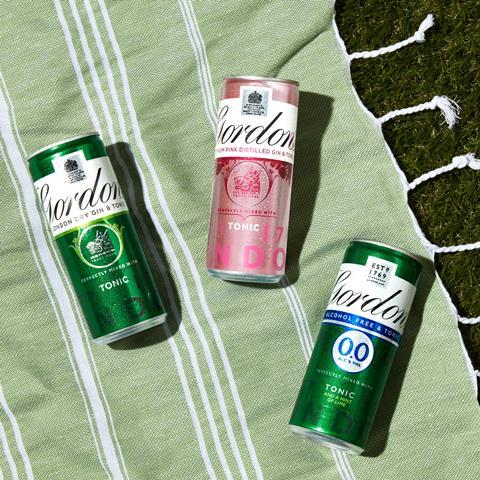
The booze giant also points to Drinkaware 2024 Monitor data showing 81% of UK adults are sticking to NHS guidelines on alcohol. They advise that adults should consume no more than 14 units of alcohol a week.
“We are encouraged by this,” says a Diageo spokesman. “Harmful consumption of alcohol is falling, and this is driving a vibrant non-alc spirits space.
“Diageo has launched a full portfolio of non-alc brands in GB to meet this consumer demand, such as Gordon’s Premium Pink 0.0.”
Still, there’s no getting away from the fact alcohol-free drinks account for just 3.3% of Gordon’s value sales. Clearly, driving growth in the hard stuff will be essential if Gordon’s is to maintain its place as Britain’s fourth-biggest alcohol brand.
RTDs are a particular focus. “Consumers today want high-quality drinks that can be enjoyed at a variety of places and spaces,” says the Diageo spokesman. “RTDs provide the perfect solution for new and traditional drinks to be enjoyed conveniently.”
To push its cocktails and spirits, Diageo has spent big on ads. “This year, the brand continued its ‘Definitive Gin’ campaign for Gordon’s London Dry, as well as launching ‘Mix it Up’ for Gordon’s Premium Pink,” explains the supplier’s spokesman. The drives “have tested as the most enjoyable Gordon’s ads ever”.
The brand’s trying to catch shoppers’ eyes in other ways, too. In February, it unveiled limited-edition labels for its Premium Pink lines, designed in collaboration with Love Island host Maya Jama.
The designs, says the spokesman, represent “the powerful energy of connecting with friends”.
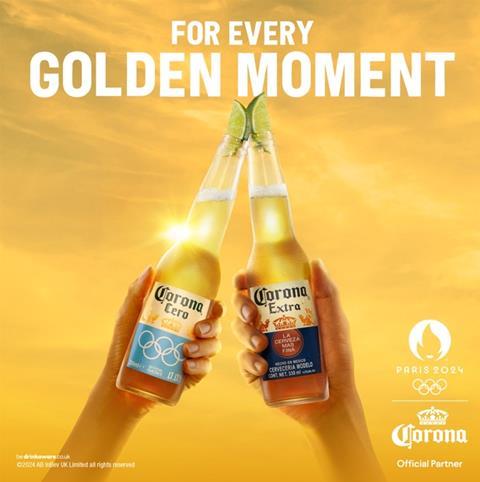
5 (8)
Corona
Sales: £303.8m
Growth: +1.0%
Corona was called out as a global hero brand by owner AB InBev in its quarterly results last month.
The lager’s performance in the UK over the past year has been a little more modest. But gains of £3m and 2.2 million litres aren’t to be sniffed at.
Nor are the performances of Corona’s alcohol-free Cero, added in 2022, and 3.2% abv Ligera, unveiled in February 2024. The sessionable duo has more than mitigated the £734.6k loss for Corona’s core lager. They’ve delivered an extra £7.2m between them, thanks to growing demand for low & no beers.
Cero likely also enjoyed a sales boost from being the official beer of the 2024 Paris Olympics. It will hold that honour again at the 2028 Olympics in Los Angeles.
Read more:
-
Britain’s Biggest Brands 2025: Riding the perfect storm
-
How premiumisation is fueling the alcohol-ready-to-drink category
-
The biggest winners and losers of Britain’s Biggest Alcohol Brands 2025
-
Britain’s next top booze brands?
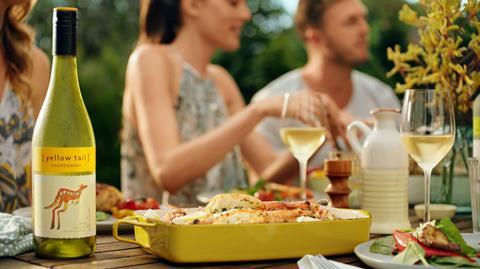
6 (11)
Yellow Tail
Sales: £292.3m
Growth: +8.0%
Grocery has a new number one in wine. While fellow Aussie brands Hardys (10), Barefoot (18), McGuigan (25) and Wolf Blass (70) are struggling to shift litres, Yellow Tail continues to rocket up our ranking.
The brand’s £21.8m gain – driven by a 5.1% rise in volume – means it’s now worth £22.3m more than closest rival Hardys.
Its success is a testament to the focus and long-term investment of owner Casella Family Brands Europe, says its MD, Simon Lawson. “Our clear vision for Yellow Tail enables us to power through category challenges and prepares us to face those still to come.”
Continued investment through the brand’s ‘Good on ya!’ campaign – now live across TV, digital and social media – is designed to keep Yellow Tail on top.
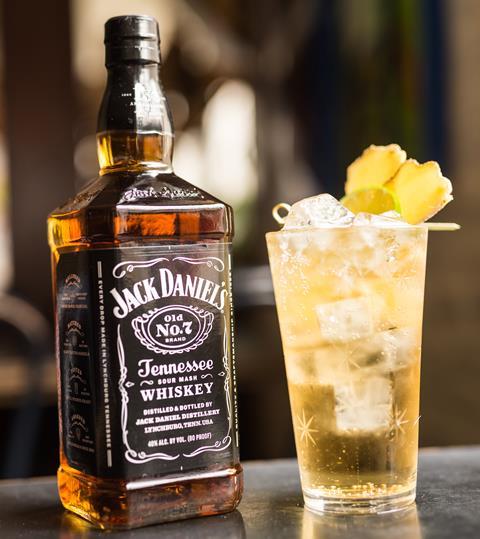
7 (10)
Jack Daniel’s
Sales: £288.2m
Growth: +0.5%
One of three spirits brands in the top 10, Jack Daniel’s is the only one showing growth across the board. It’s up £1.4m on a 2.9% jump in volumes.
That means it’s outpacing rival whisky brands like The Famous Grouse (22), Whyte & Mackay (40), Bell’s (46), Grant’s (74) and Jim Beam (75), all of which have shed litres.
The sheer power of JD keeps it facing upwards, says a spokesperson for owner Brown-Forman. “Jack Daniel’s is a brand with incredibly strong brand equity, which means it can withstand challenging conditions.”
Plus, its partnership with McLaren in Formula 1 is proving a winner. The team won the 2024 Constructors Championship – marked with a 43% abv McLaren limited-edition this spring.
8 (7)
San Miguel
Sales: £279.0m
Growth: –11.9%
San Miguel’s £37.6m loss is rather surprising. After all, continental lager is in great demand, buoying the likes of Birra Moretti (13), Peroni (16) and Madrí Excepcional (33).
On 1 February 2025, the licence to produce and distribute San Miguel switched from Carlsberg Marston’s Brewing Company to Budweiser Brewing Group – which is remaining tight-lipped about the brand’s performance.
Efforts to reverse the 15.3 million-litre loss included ‘Fly San Miguel’ last month – a party at the Number 90 Bar in Hackney Wick, London.
Held in association with Mixmag, it featured headliner DJ Daniel Pearce, aka Eats Everything. Guests who turned up with their passports had the chance to be flown to Ibiza directly from the event.
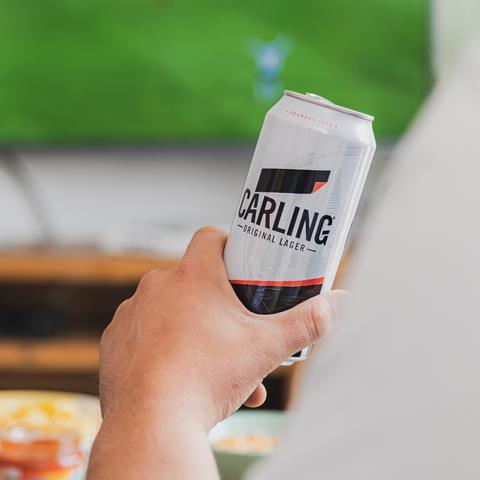
9 (5)
Carling
Sales: £275.7m
Growth: –13.6%
Carling’s losses have picked up speed since last year. It’s down £43.3m – the second-biggest absolute loss in the top 100. Only Hardys (10) has shed more money in the past year.
But owner Molson Coors is confident footie will help reverse Carling’s fortunes. It continues to invest in both the men’s and women’s FA Cup and Scottish Premier League.
The brand “has its roots in football”, says Kevin Fawell, UK sales director. “And with a huge summer ahead for women’s football, it’s exactly the kind of brand fans turn to as they get ready to enjoy the action.”
However, it should be noted that Foster’s (11), Carling’s closest rival, is also performing poorly. That’s a clear sign consumers are moving to fancier lagers like Birra Moretti (13) and Cruzcampo (38).
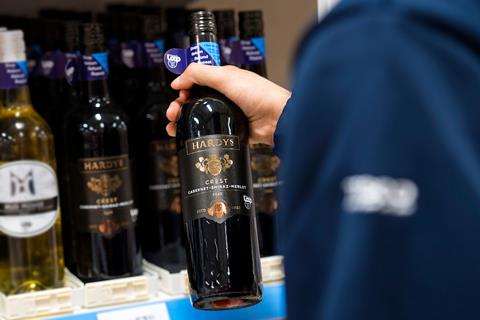
10 (6)
Hardys
Sales: £270.0m
Growth: –14.9%
Hardys, the UK’s bestselling wine brand, has suffered the greatest absolute loss in this year’s ranking. It’s suffered a £47.4m hit to its top line, as retailers have sold 6.7 million fewer litres.
Despite this downturn, owner Vinarchy remains upbeat. “The brand’s overall health remains robust,” says marketing & category director Tom Smith. “This is underpinned by long-standing consumer trust and recognition.”
Hardys’ decline is partly down to the “strategic scaling back” of its cheaper Stamp lineup, says Smith. It’s worth £56.8m, following a value plunge of 34.2% on volumes down 36.5%.
However, the challenges extend beyond Stamp. Hardys has also suffered distribution losses in the face of significant market share gains for own label wine.
These pressures have led to the brand’s mid-priced range, VR, declining by 6.1% in value and 5.6% in volume. Bargain lineup Nottage Hill and the pricier Voyage and Bin 161 selections have also made significant contributions to Hardys’ overall decline.
These losses come after last October’s £1m investment in OOH advertising and sponsorship of ITV’s drama programming.
Using the slogan ‘The Joy of Certainty’, the push focused on Hardys’ higher-end Crest Cabernet Shiraz Merlot in TV idents and large-format displays at travel hubs across the UK.
“The ‘Joy of Certainty’ campaign has delivered strong results in consumer testing,” says Smith.
“The focus is on amplifying the campaign’s reach, supported by investment in marketing and advertising to further strengthen perception and visibility of the Hardys brand,” he adds.
Given the new system of wine duty, pricier Hardys wines may need that extra bit of help. Until February 2025, all wines were taxed as if they were 12.5% abv. But with the introduction of new government policy, wine is now taxed in 0.1% abv increments.
That means a lot of punchy reds, such as Hardys’ 14% abv Crest Cabernet Shiraz Merlot, now cost more, threatening future volume sales.
So much for the joy of certainty.
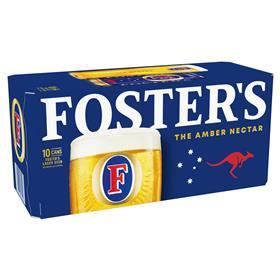
11 (9)
Foster’s
Sales: £252.8m
Growth: –13.7%
Supermarkets sell more lager than all other beers combined, but some of the biggest brands are falling. Among them is Foster’s. It’s shifted 19 million fewer litres as craft and world lagers dominate the market.
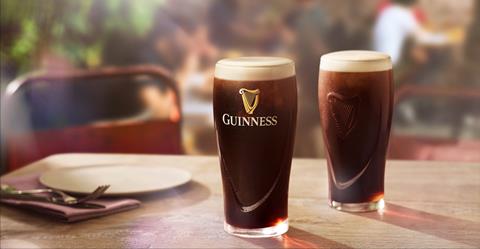
12 (17)
Guinness
Sales: £240.4m
Growth: +14.1%
Black beer’s back in fashion – and Guinness is cashing in. The UK’s number one stout is worth an extra £29.7m, having sold an extra 8.7 million litres over the past year.
Such is the brand’s popularity that it last year inspired JW Anderson’s spring collection at Milan Fashion Week. It included £890 merino wool jumpers emblazoned with the Guinness logo.
The brand was also the star of social media trend ‘splitting the G’. That’s taking a first glug from a pint so big that the line between the beer and head bisects the Guinness branding on the glass.
Demand for the black stuff eventually reached a frenzy in the autumn, leading to pubs running out.
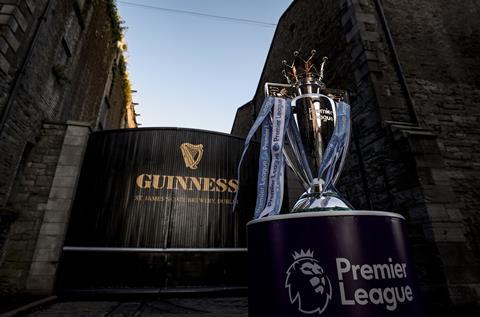
In grocery, owner Diageo was forced to limit supply to retailers, in the hopes of avoiding a Christmas shortage.
The core Draught beer – up £12.2m – isn’t its only source of growth. Its alcohol-free variant, 0.0, is worth an extra £14.2m, having satisfied Brits’ thirst for low & no booze.
So it’s no wonder Diageo – which this January rebuffed reports it was planning to sell the buoyant brand – is upbeat.
“We truly see Guinness as a 267-year-old success story, with today’s popularity years in the making,” it says. “Our role is to supercharge recruitment by bringing the magic of Guinness to more consumers on more occasions.”
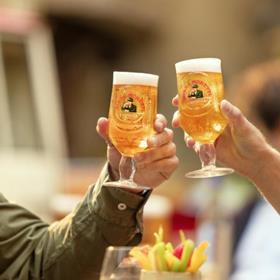
13 (16)
Birra Moretti
Sales: £238.3m
Growth: +10.5%
Moretti’s strong Christmas sales, driven by its biggest-ever festive push, ended a successful 2024. Recently launched global campaign ‘Enjoy Life’s Simple Pleasures’ is expected to maintain its growth trajectory.
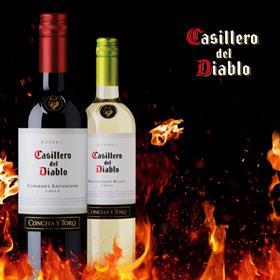
14 (20)
Casillero del Diablo
Sales: £225.1m
Growth: +7.8%
Casillero del Diablo has enjoyed volume growth of 4%. Its range is now “relevant for more occasions, through innovation in growing areas of the category and alternative formats”, says owner Concha y Toro UK.
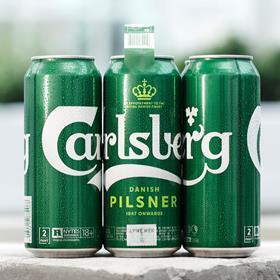
15 (15)
Carlsberg
Sales: £224.4m
Growth: +3.8%
Carlsberg’s 11.5% volume gain is due to “bold campaigns and meaningful partnerships” such as listings for its 24-can pack, says brand director Jo Marshall. They drove “distinctiveness in a competitive market”.
16 (13)
Peroni
Sales: £224.0m
Growth: +1.2%
Last summer, Asahi UK kicked off retailer and marketing activity for Peroni’s Nastro Azzurro and Stile Capri lagers. It included giving away over 150,000 samples of Stile Capri in Waitrose and Tesco.
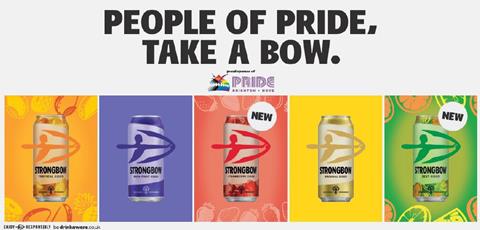
17 (12)
Strongbow
Sales: £220.9m
Growth: –9.1%
The moderation trend has sent the cider market into decline. But Strongbow remains Britain’s biggest cider due, in no small part, to “bold steps to reposition itself”, it says. It added Strawberry last summer.

18 (14)
Barefoot
Sales: £217.2m
Growth: +0.2%
The past year “presented challenges” for wine, says Barefoot, which “continued to demonstrate a steady performance”. It kicked off a £2m push last month in a bid to maintain momentum.
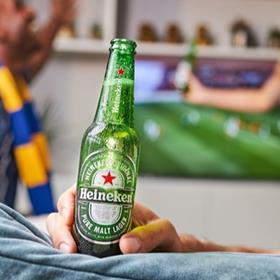
19 (18)
Heineken
Sales: £212.2m
Growth: +1.1%
Alcohol moderation played a huge role in Heineken’s performance, says the brewer. A Dry January 2024 partnership with Welsh football’s Gareth Bale made Heineken 0.0 “unmissable to shoppers”.
20 (21)
BrewDog
Sales: £206.6m
Growth: +0.7%
BrewDog’s got a new CEO and a new look. The changes come after the brewer added just £1.4m and 1.4 million litres. Last year, it launched Cold Beer and Juice Shack – followed by a raft of fruity brews in 2025.
Britain’s Biggest Alcohol Brands 2024:
-
BBAB 2024: The top 100
-
How drinks brands are embracing moderation
-
Cruzcampo makes a splash in biggest booze brands list
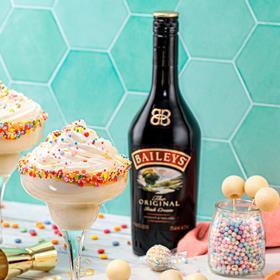
21 (22)
Baileys
Sales: £203.3m
Growth: +1.4%
Christmas favourite Baileys wants to “appeal to a multi-generational audience all year round”, says owner Diageo. To that end, it added Toffee Popcorn: Movie Night in May to tap “new treating occasions”.
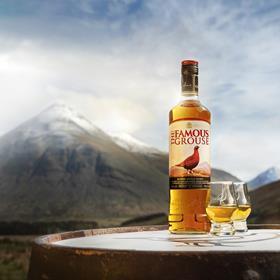
22 (19)
The Famous Grouse
Sales: £202.5m
Growth: –3.3%
The Famous Grouse remains comfortably the largest scotch whisky in the off-trade – despite a £7m loss. Volumes are down 8.1%. The brand’s acquisition by William Grant & Sons was greenlit in March by the CMA.
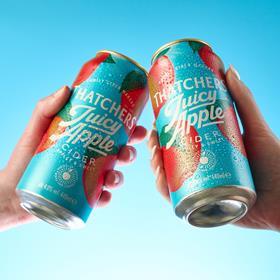
23 (25)
Thatchers
Sales: £198.8m
Growth: +7.1%
In the courts, Thatchers won a trademark case over Aldi. In the mults, the brand won share. Volumes are up 4.1%. August saw the launch of Juicy Apple, a 4% abv cider made using 100% renewable electricity.
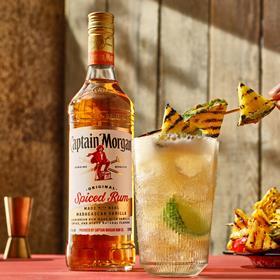
24 (23)
Captain Morgan
Sales: £197.4m
Growth: +2.2%
Highlights for Captain Morgan included a tie-up with Pepsi Max to launch a 5% aby RTD in September. It’s aimed at “consumers wanting to enjoy high-quality serves in more places and occasions”.
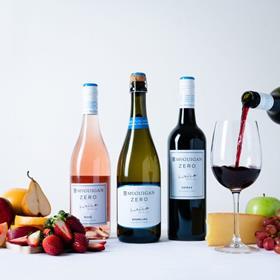
25 (24)
McGuigan
Sales: £180.9m
Growth: –4.0%
McGuigan’s hero Black Label range turned 30 in 2025. “Significant” investment in celebratory activations didn’t prevent the overall brand recording a value loss for the fourth year in a row, however.
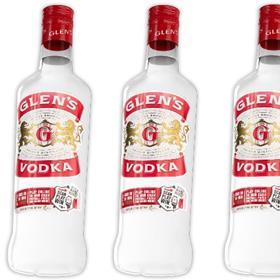
26 (26)
Glen’s
Sales: £166.7m
Growth: –9.5%
Glen’s has lost £17.6m as average price per litre has risen about 7%. In September, the c-store vodka was the victim of counterfeiting. Fake 35cl bottles contained potentially lethal industrial solvent.

27 (27)
Kopparberg
Sales: £152.8m
Growth: –8.0%
In the face of falling sales, Kopparberg has gone big on NPD. Most notable was December’s Crisp Apple, timed to tap “the resurgence of apple cider”, says senior customer marketing manager Axel Tulip.
28 (28)
Kronenbourg
Sales: £150.0m
Growth: –0.2%
In April 2024, Kronenbourg 1664 was rebranded to take emphasis off ‘Kronenbourg’ in favour of ‘1664 Bière’. The brand also got a new visual identity and pack design.
“Since then, we’ve seen strong growth in our volumes, and looking at our most recent quarter, value, rate of sale and distribution are all in growth ahead of the wider category and our key competitors,” says Dharmesh Rana, brand director for premium at owner Carlsberg Britvic.

The picture’s a little different over the full year, however. While volumes are up 4.2%, or 2.5 million litres, value has dipped into the red by £300k.
Still, matters could have been much worse. The addition in January 2024 of 1664 Blanc, a premium wheat beer with citrusy notes, has proven to be Kronenbourg’s saving grace. It’s made £4.2m in just over a year on supermarket shelves.
The launch has kickstarted “exceptional momentum” for the brand, insists Rana. That 1664 Blanc has shifted 1.1 million litres is testament to Kronenbourg’s “consistent focus on quality, innovation and premium positioning”.
That focus was also seen this March, when the brand added alcohol-free 1664 Bière 0.0 – billed as “a perfectly balanced, flavourful and eminently sippable beer”.
It’s already proving itself in the competitive low & no aisle, says Rana, “performing ahead of key competitors, both in-store and on draught”.
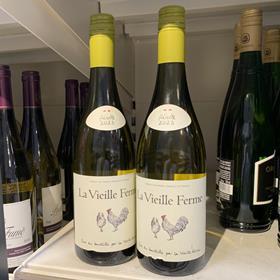
29 (47)
La Vieille Ferme
Sales: £132.5m
Growth: +59.1%
It’s been an “absolutely extraordinary” year for La Vieille Ferme, says Andrew Bayley, MD of owner Famille Perrin UK&I. The brand’s nailed the top 100’s second-fastest value growth after going viral.

30 (29)
Bacardí
Sales: £128.4m
Growth: –3.5%
To recoup losses, Bacardí has leaned into NPD. In April this year, it linked with Coca-Cola for an RTD cocktail. Then came the May relaunch of Breezer in response to “strong demand from a new generation”.
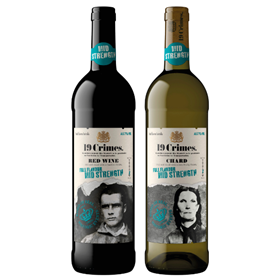
31 (31)
19 Crimes
Sales: £126.8m
Growth: –0.6%
After years of stellar growth, 19 Crimes has finally stalled. Its dip in value comes with a 2.5% fall in volumes. The brand rolled a 7% abv wine range into Sainsbury’s stores in September to attract younger consumers.
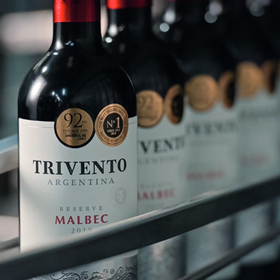
32 (32)
Trivento
Sales: £125.6m
Growth: +3.4%
The ‘Savour the Sobremesa’ push launched in April was well received by consumers, says Viña Concha y Toro. But volumes are up just 0.9% – a major slowdown after the 13.6% gain reported last year.
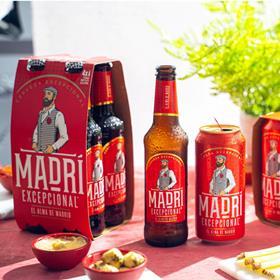
33 (33)
Madrí
Sales: £123.7m
Growth: +9.6%
Distribution increases and activations were at the heart of Madrí’s growth. It’s made the fourth-biggest absolute gain of any beer brand: £10.8m. In March, it added Zero, an alcohol-free lager.
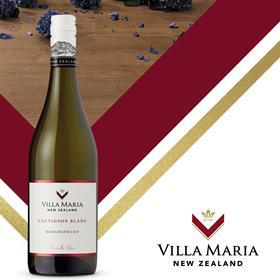
34 (39)
Villa Maria
Sales: £115.7m
Growth: +19.2%
Villa Maria is the top 100’s fourth fastest-growing wine this year, adding £18.6m on volumes up 21.9%. It follows its ‘Live in the Delicious’ push and the launch of Private Bin Sauvignon Blanc in a 200ml can.
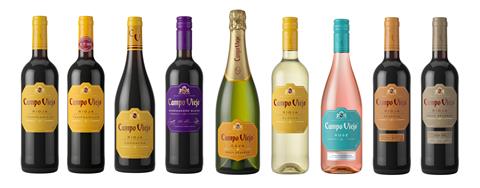
35 (34)
Campo Viejo
Sales: £111.1m
Growth: –0.7%
Campo Viejo says it kept losses to a minimum thanks to “strong media investment to drive both awareness and engagement”. That included a year-long sponsorship deal with E4’s prime entertainment strand.

36 (30)
I Heart
Sales: £108.3m
Growth: –16.0%
Wine is among the luxuries Brits have scaled back on in the past year. The money-saving trend, coupled with a “notable delist in one of the grocers”, has caused I Heart sales to slump.
The brand’s lost £20.6m – £17.2m of which comes from its flagship still wines. Their volumes are down 21.5%.
I Heart’s core prosecco has fared slightly better. Litres have fallen just 4.2%, compared to the brand’s overall 16.7% slump. The prosecco’s relative success was due to a lower average price per litre, which pushed down value by 9.8%.
Further challenges could be ahead for I Heart. Owner Freixenet Copestick has spoken of the potential impact of both extended producer responsibility and changes in duty on wine.
Since February 2025, duty has been charged at 0.1% volume increments. The change only adds “additional and unnecessary complexity”, Rob Hilton, Freixenet Copestick operations director, told trade title The Buyer last December. It’s also made stronger wines pricier. As such, the supplier has taken alcohol out of some of its lines to maintain affordability.
Hilton is confident I Heart can get back on track: “2025 is already looking good – we are filling in the distribution gaps and gaining sales in the sparkling sector.”
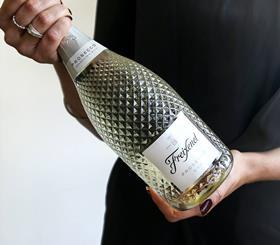
37 (38)
Freixenet
Sales: £107.0m
Growth: +5.3%
Freixenet’s volumes have fizzed 10.7%. Two variants – Brut and Rosé Royal – debuted in Tesco last August and soon snagged a Sainsbury’s listing. In March, it unveiled a redesign aimed at 25 to 34-year-olds.
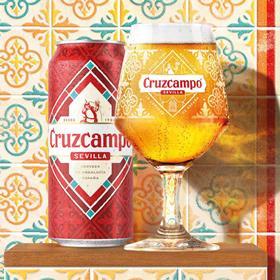
38 (96)
Cruzcampo
Sales: £103.9m
Growth: +246.5%
Cruzcampo is the top 100’s superstar for the second year running. The brand has tapped “shoppers’ growing demand for more premium continental lagers that still offer value for money”, says owner Heineken.

39 (35)
Jam Shed
Sales: £103.5m
Growth: –1.7%
Last November, Jam Shed added Shiraz to its ‘mini box’ range. The 1.5-litre pack was joined in March by Bubbly Rosé in a 200ml can. That was followed in May by a regular bottle of White Blend – a Morrisons exclusive.

40 (37)
Whyte & Mackay
Sales: £98.7m
Growth: –3.2%
Blended whisky is struggling, and Whyte & Mackay is no exception – having lost £3.2m in the past year. After its distillery workers walked out during a pay dispute last summer, volume sales are down 6.8%.
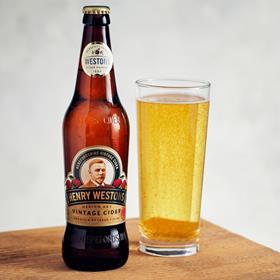
41 (42)
Henry Westons
Sales: £96.1m
Growth: 5.5%
Bucking cider’s slump, Henry Westons has made an extra £5m on volumes up 2.3%. Innovation has been key. The brand launched Vintage Pear in February 2024, followed 12 months later by 1880 Vintage.

42 (36)
Isla Negra
Sales: £93.3m
Growth: –11.3%
In 2023, Isla Negra slashed the abv of its wines to duck a rise in duty and keep a lid on prices. Sales subsequently soared. But volumes have dived 13.6% in the past year in the wake of lost Iceland listings.
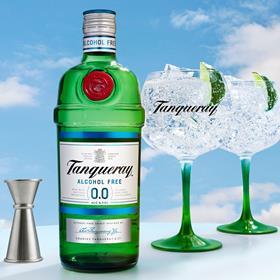
43 (45)
Tanqueray
Sales: £93.2m
Growth: +9.5%
Tanqueray’s volumes are up 13.4%. Its alcohol-free 0.0 and Negroni pre-mixed cocktail were “key sources of growth”, says owner Diageo. The brand has also pushed its core gin via the ‘It’s Showtime’ campaign.
![]()
44 (40)
Absolut
Sales: £92.8m
Growth: –0.2%
Absolut hooked up with Sprite in February 2024 for a 5% abv RTD. A Watermelon variant followed in April 2025. The canned cocktail’s added £4.2m, helping to markedly slow down Absolut’s overall decline.
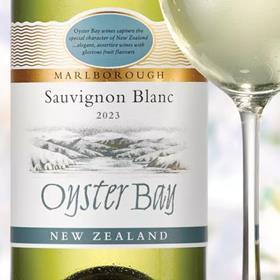
45 (41)
Oyster Bay
Sales: £91.1m
Growth: –1.6%
A 4.3% dip in volumes is more bad news for Oyster Bay owner Delegat. It issued another profit warning on the New Zealand stock exchange in April 2025, due to the impact of Trump’s tariffs on overseas goods.
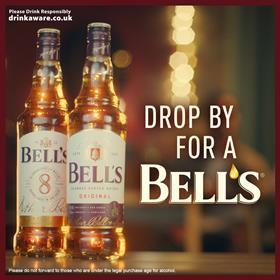
46 (43)
Bell’s
Sales: £90.2m
Growth: +0.8%
With no NPD to boost Bell’s volumes, they’ve fallen 5.5%. Still, owner Diageo is upbeat about its roster of whisky brands, which includes single malts: “Diageo has amazing breadth in its whisky portfolio.”
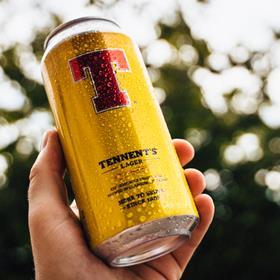
47 (48)
Tennent’s
Sales: £84.3m
Growth: +1.3%
Tennent’s volumes are down 6.8%. That’s after minimum unit pricing in its homeland of Scotland went from 50p to 65p per unit last September. It helped drive up the lager’s average price per litre by 8.7%.
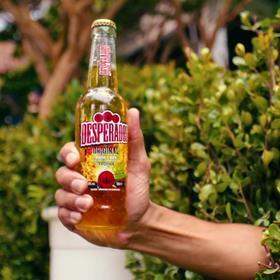
48 (46)
Desperados
Sales: £82.2m
Growth: –1.4%
Desperados launched cocktail-inspired beers Mojito, Caipirinha and Daquiri into wholesale and convenience in September 2024. They’ve made a big impression in impulse, says owner Heineken UK.
49 (50)
Jameson
Sales: £80.0m
Growth: +5.3%
It’s been a stressful few months for makers of Irish whiskey. Most crucially, Donald Trump has threatened tariffs of up to 50% on EU imports – which would deal a devastating blow to sales in one of their largest export markets.
In April, Jameson owner Pernod Ricard went as far as to admit its portfolio faced a “challenging and very fluid” global macroeconomic and geopolitical environment.
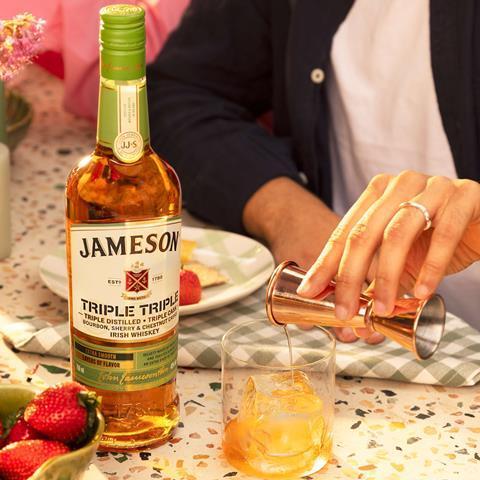
At least UK grocery sales are nothing to stress about. Jameson has recorded a £4m gain on 4.5% growth in litres.
Staying front of consumers’ minds has been a core part of the brand’s strategy. This February, it invested in a multimillion-pound push to mark St Patrick’s Day, including a TV ad and Sky Sports tie-up to complement Jameson’s long-standing partnership with the English Football League.
That campaign was preceded by January’s digital activity in collaboration with Drinkaware and former England striker Jay Bothroyd, to encourage fans to keep check of their drinking habits.
And last October, Jameson partnered with sportswear brand Admiral to launch a retro tracksuit.
On the NPD side, the brand added Triple Triple Chestnut Edition in February – just a month before its distillery announced a three-month pause in production to “support the sustainable global growth” of its portfolio.
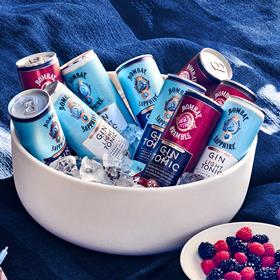
50 (51)
Bombay
Sales: £70.6m
Growth: –7.0%
Bombay is aiming to recoup its £5.3m loss with ‘Step Into The Blue’. The push for its core Sapphire gin kicked off in May 2025, linked with sponsorship of powerboat race championship the UIM E1 Series.
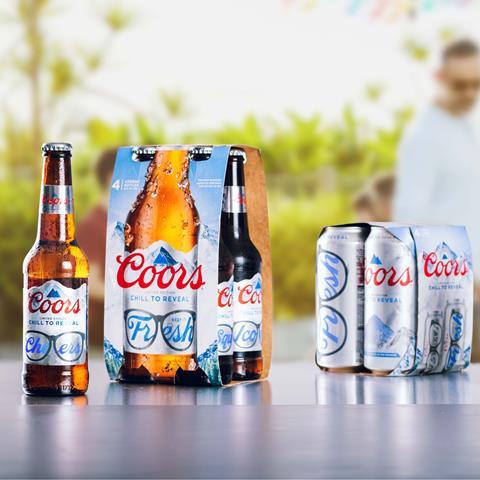
51 (49)
Coors
Sales: £69.0m
Growth: –16.7%
In May, Molson Coors Beverage Company (MCBC) kicked off what it described as “the biggest campaign yet for Coors in the UK”.
The £6m investment was designed to win over a younger generation of more discerning – but still value-driven – beer-drinking Brits.
The ‘Peak of Technology’ push, which will continue until September, features influencer content that plays on key cultural moments and “relatable tech fails”.
“It is a playful nod to Coors’ signature cold-activated packaging – featuring mountain icons that turn blue when the beer reaches optimal drinking temperature,” says Kevin Fawell, UK sales director at MCBC. “This forms part of a broader strategy to modernise its image, connect with a new generation of drinkers and help our customers tap into this market.”
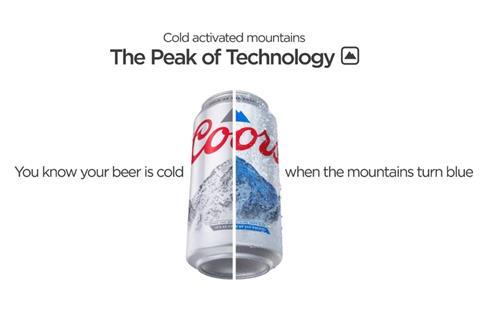
It’ll need to work hard to reverse Coors’ lacklustre performance of the past year, though. The brand, which cut its abv in the spring from 4% to 3.4%, has lost £13.9m and 5.7 million litres. Still, Fawell remains optimistic. “Familiar, trusted favourites like Coors” continue to have a strong pull, he insists.
“It’s an essential component of any beer aisle, offering something a bit more premium to shoppers that want to trade up, but aren’t looking to go quite as far as world beers.”

52 (55)
Estrella Damm
Sales: £66.1m
Growth: +3.9%
Continental beers are booming – and Estrella is no exception. Volumes are up 4.2% after the successful 2024 launch of a 4x440ml pack of cans. Last summer saw the release of four-minute ad Verano ’78.
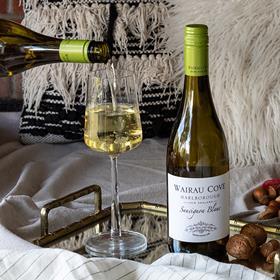
53 (52)
Wairau Cove
Sales: £63.5m
Growth: –2.2%
Lower average prices are helping Wairau Cove, the Tesco-exclusive sauvignon blanc, to slowly turn around its sluggish performance. Volumes are down 1.9% compared with the 5.4% decline reported last year.
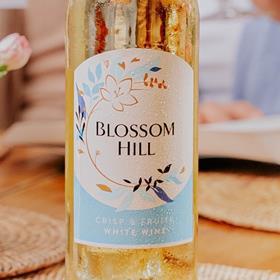
54 (44)
Blossom Hill
Sales: £63.1m
Growth: –28.9%
Blossom Hill is in freefall. But owner Treasury Wine Estates axed plans to sell it and other “commercial” brands this February, after deciding offers received “did not represent compelling value”.

55 (53)
Echo Falls
Sales: £60.1m
Growth: –7.0%
Echo Falls’ litres have fallen 9.1% at “a time when price sensitivity is high”, says owner Vinarchy. But its Watermelon & Kiwi, added in February 2024, has “resonated with” Brits who don’t care for regular wine.
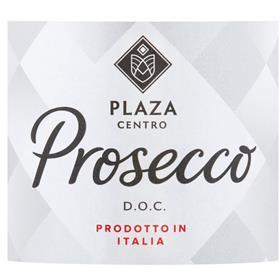
56 (54)
Plaza Centro
Sales: £59.9m
Growth: –5.9%
Plaza Centro has shed £3.8m and lost 1.7% of its volumes. The performance of the Tesco-exclusive prosecco largely mirrors that of the wider sparkling wine market, which has lost its Covid bounce.
57 (57)
Malibu
Sales: £59.5m
Growth: –0.5%
The rum-based coconut liqueur enlisted Succession star Brian Cox in February for the second iteration of its ‘Do Whatever Tastes Good’ campaign, as it sought to keep volumes in the black. Growth’s slowed to 2.9%.
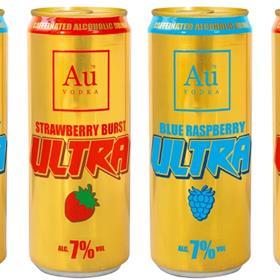
58 (75)
Au
Sales: £58.7m
Growth: +40.1%
Au continues to rocket up the ranking. Its flavoured vodkas and cocktails, packed in gold bottles and cans, have grown volumes by 73.6%. April 2025 welcomed Ultra, a 7% abv caffeinated RTD range.
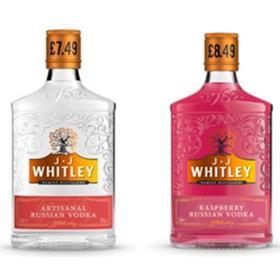
59 (56)
JJ Vodka
Sales: £56.0m
Growth: –11.5%
Like bigger rivals Smirnoff (2) and Glen’s (26), JJ Vodka has had a poor year. Its litres are down 11.6% as mainstream voddy struggles to excite Brits. Marshmallow was one of the few variants to grow volumes.
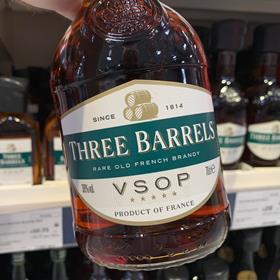
60 (60)
Three Barrels
Sales: £55.5m
Growth: –4.2%
Britain’s biggest brandy continues to struggle – volumes have sunk 7.5%. The tipple’s premium XO variant underwent a significant relaunch last year, heralding a “new chapter of a well-loved brand”.
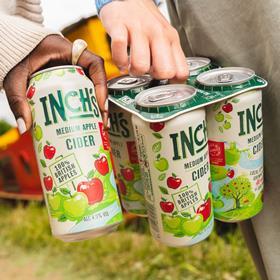
61 (82)
Inch’s
Sales: £54.1m
Growth: +40.3%
Inch’s 39.1% volume gain demonstrates Brits’ “love for the cider category”, the brand says. This March, it added Cloudy and the zero-alcohol 0.0 – both supported by a major push that will run until September.
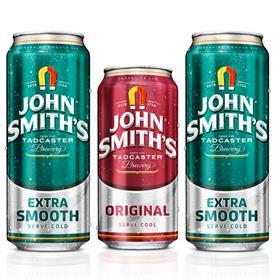
62 (59)
John Smith’s
Sales: £53.9m
Growth: –7.9%
John Smith’s “distinctive cereal character” has not prevented volumes falling 2.6%. But the brand insists it “can create nostalgia through shop displays, to inspire customers within path to purchase”.
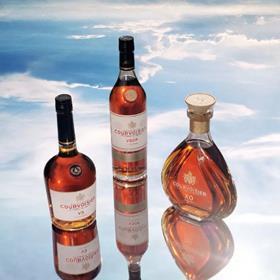
63 (61)
Courvoisier
Sales: £53.1m
Growth: –3.1%
Having shed £1.7m and 2.6% of its volumes, Courvoisier has teamed up with jazz superstars Ezra Collective for a push to “inspire everyone to cherish and celebrate life’s precious moments”.

64 (64)
Buckfast
Sales: £51.7m
Growth: +3.1%
Made by Benedictine monks, Buckfast is “equally rich in heritage as it is in taste”, it insists. Its value sales have been boosted by rising prices, but volumes continue to fall. They’re down 3.3%.
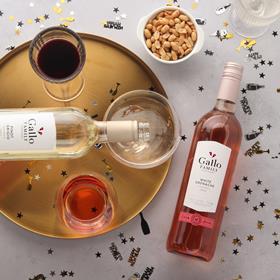
65 (58)
Gallo Family Vineyards
Sales: £51.7m
Growth: –13.1%
Gallo positions itself as affordable, but it hasn’t been immune to price-sensitive shoppers scaling back on boozy treats. It’s lost £7.8m – £6.1m of which comes from its core range of table wines.
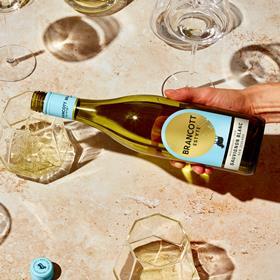
66 (77)
Brancott Estate
Sales: £50.8m
Growth: +23.5%
Brancott boasts the second-highest percentage value gain of any wine in the top 100. That’s down in part to distribution gains. Lighter option Flight “continues to be a significant growth driver”, it says.
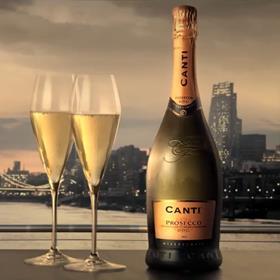
67 (63)
Canti
Sales: £50.7m
Growth: –1.3%
Canti’s volumes are down 3.7%, or 0.2 million litres. But there’s hope for a turnaround: this spring, the brand bagged a spot in Square Meal’s guide to the best value bottles of prosecco on the market.
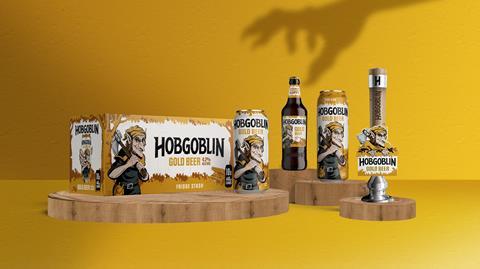
68 (73)
Hobgoblin
Sales: £48.5m
Growth: +13.1%
Less than a year after Carlsberg Britvic put up the cash for an eye-catching refresh, Hobgoblin has made good on its owner’s investment.
The ale brand has added £5.6m and recorded a 16.7% rise in volumes.

“Rooted in heritage and shaped by audience insight, our new design elevates Hobgoblin’s presence in today’s competitive beer landscape,” says Jo Marshall, brand director for core & craft at Carlsberg Britvic.
Spearheading success is Hobgoblin Gold, which has added just under £3m to overtake Hobgoblin Ruby and become its bestselling variant.
Hot on its heels is the lighter Hobgoblin Session IPA, a 3.4% abv beer designed to cater to more moderate drinking tastes. It’s up by £4m.
“Hobgoblin has been proving the brand’s strength and quality with the significant overperformance vs the category,” says Marshall.
“We can attribute a lot of this success to the launch of fantastic beers like Hobgoblin Session IPA, but we have also put a focus on increasing the distribution of pack formats which are in demand from our consumers, such as our 10-can packs and pint cans.”
The brand has continued to innovate with the launch of Hobgoblin Amber in March. The brew is made with hops like Fuggles, Progress, Herkules and Goldings to create “well-rounded hoppiness”.

69 (66)
Moët & Chandon
Sales: £47.3m
Growth: –3.9%
It’s not surprising Brits have cut back on champers while grappling with hikes in their living expenses. The shocker, perhaps, is that market leader Moët & Chandon has lost just 4.6% of volumes.
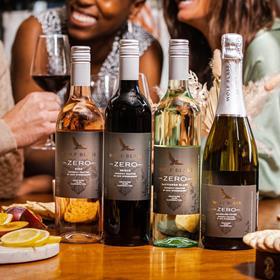
70 (65)
Wolf Blass
Sales: £46.7m
Growth: –5.8%
Australian winery Wolf Blass has faced a tough year, but its affordable Vineyards Release range has fared better. It’s doubled value to £10.9m as shoppers opt to keep a tight lid on their budgets.

71 (86)
Asahi Super Dry
Sales: £46.3m
Growth: +23.6%
Asahi Super Dry is at the top of its game in the UK. The Japanese lager brand has realised the fifth-fastest value rise in the top 100 and the fifth-biggest absolute gain of any beer brand in this report. It’s up 23.6%, or £8.8m, having grown volumes 20.1%.

The brand’s alcohol-free variant, 0.o%, has contributed £630k to that total. Its value’s up 37.9% on volumes up 32.5%.
Asahi is now banking on sponsorship of one of this summer’s biggest sporting events to generate further growth. “The Women’s Rugby World Cup 2025 is set to be a landmark event, and we’re committed to helping our retail partners fully capitalise on this,” says Asahi marketing director Rob Hobart.
Activity includes an on-pack promo that gives shoppers the chance to win match tickets and other prizes. There will also be activations in partnership with Kettle Chips in Waitrose and Sainsbury’s.
“Our £2m campaign offers comprehensive support, from high-impact media to a suite of PoS materials,” adds Hobart.
Asahi will also splash out on advertising and influencer marketing backed by England and Harlequins full-back Ellie Kildunne (pictured).
The World Rugby Women’s 15s Player of the Year 2024 says the partnership will help “foster a deeper connection with the tournament and Asahi Super Dry”.
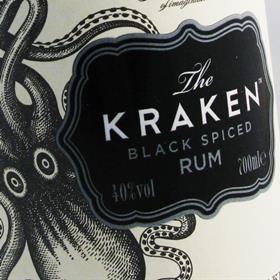
72 (71)
The Kraken
Sales: £45.9m
Growth: +4.1%
“The Kraken has maintained a strong identity despite evolving category trends,” it says. The rum brand’s grown volumes 7.1%, after last autumn’s launch of limited-edition Dark Caramel & Cornish Sea Salt.

73 (62)
Johnnie Walker
Sales: £44.9m
Growth: –15.5%
Last month, Diageo confirmed major cost-cutting across its whisky portfolio, led by Johnnie Walker. It follows a tough year for the brand, whose bestselling Red Label lost £9.1m due to changes in distribution.

74 (69)
Grant’s
Sales: £43.9m
Growth: –3.6%
William Grant & Sons reported a 14% rise in revenues in its latest results. But it’d be safe to say that didn’t come from Grant’s, its best-known blended whisky. Stuck in an unfashionable sector, it’s lost £1.6m.
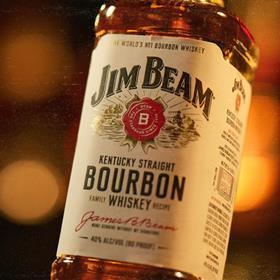
75 (68)
Jim Beam
Sales: £43.5m
Growth: –5.9%
Over the past year, Jim Beam has been busy marketing its seven-year-aged Black bourbon, and added a Pineapple tipple this March. None of that has stopped volumes falling, mind. They’re down 10.8%.

76 (72)
Whitley Neill
Sales: £42.6m
Growth: –1.1%
The UK’s “number one premium gin” has suffered a 4.8% fall in volumes. In positive news, Whitley Neill was named the UK’s favourite gin in October, in a survey by market research provider Savanta BrandVue.

77 (78)
Staropramen
Sales: £42.3m
Growth: +3.4%
Staropramen has grown volumes 2.5%. That’s been bolstered by a push with Orlando Bloom and efforts to drive sales in convenience. The brand added a 10x440ml fridge pack of cans this March.

78 (76)
Mud House
Sales: £41.7m
Growth: +0.9%
Mud House got a bag-in-box format in October. At the time, owner Accolade Wines admitted to “huge consumer barriers” around quality perception. Still, the brand’s volume sales are encouraging. They’re up 2.5%.

79 (80)
The Ned
Sales: £40.9m
Growth: +3.6%
New Zealand’s The Ned has grown the value of its core wine range, which costs a fairly reasonable average of £11.65 per litre, by 6.7%. The value of its pricier Black Label lineup, by contrast, has plunged 11%.
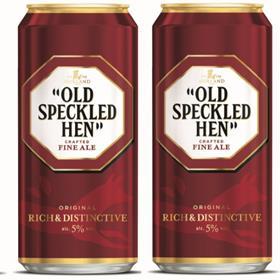
80 (70)
Old Speckled Hen
Sales: £39.9m
Growth: –11.6%
Old Speckled Hen has shed £5.2m and 2.5 million litres. Its tough year came as owner Greene King faced rising input costs, including those linked to EPR, says Jemma Williams, the brewer’s grocery lead.
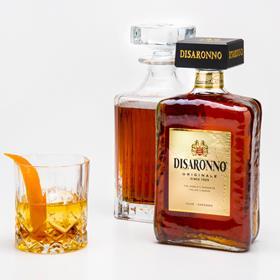
81 (79)
Disaronno
Sales: £39.6m
Growth: –2.2%
Disaronno’s volume sales have fallen 3.1%. But the amaretto brand – which is this year marking its 500th anniversary with a major campaign – claims to be “significantly outperforming the market”.

82 (85)
Chekov
Sales: £38.9m
Growth: +3.5%
A rise in average price per litre has pushed Chekov’s value into the black, while volume losses have slowed to 1.5%. The Booker-exclusive vodka got a label redesign last year, for the first time in a decade.

83 (67)
WKD
Sales: £38.1m
Growth: –18.3%
“RTDs have always been a fiercely competitive category,” says Scott Bell at WKD owner SHS Drinks. So tough is the competition that the brand has lost £8.6m. But it’s equipped to make a comeback, Bell insists.

84 (84)
Southern Comfort
Sales: £37.9m
Growth: –0.1%
The average price per litre of Southern Comfort has fallen, leading to flat value sales. In March, the brand teamed up with British rapper Aitch on a limited-edition bottle of its American whisky liqueur.

85 (95)
Kylie Minogue
Sales: £36.6m
Growth: +21.2%
Celebrity-backed booze brands are a dime a dozen nowadays. Hollywood heavyweights Margot Robbie, Tom Holland and Idris Elba all joined the ranks in 2024 alone. But few can match the credibility of Kylie Minogue and her wines.

Launched in May 2020, to coincide with the pop star’s 52nd birthday, the brand has now sold more than 20 million bottles worldwide thanks to consecutive years of double-digit growth. In the UK, it’s added £6.4m in the past 12 months alone.
The 2024 launch of its prosecco is behind two-thirds of that growth. The fizz, made by Italian producer Zonin, has clocked up an extra £4.4m – surpassing the brand’s table wine to become its bestseller.
New distribution deals for its low & no variants, including a tie-up in all UK Soho House venues from January 2025, have further buoyed the brand’s success.
To coincide with its fifth anniversary this year, the brand added limited-edition Côtes des Provence Rosé.
It’s also encouraging shopper engagement with a neck-flag campaign across its bottles. It offers the chance to win merch or even a call from Kylie. “In just one month, the activation has generated over 4,000 entries – already surpassing the total participation of a leading cider brand’s entire 16-week summer campaign last year,” says Alex Lynch, senior brand manager at owner Benchmark Drinks.
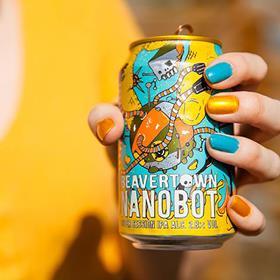
86 (92)
Beavertown
Sales: £36.3m
Growth: +9.3%
Beavertown has enjoyed a 19.8% rise in volumes – a rate of growth only surpassed by two other top 100 beers. To tap the fruit beer trend, the Heineken brand added Berry Punch and Watermelon Punch this March.
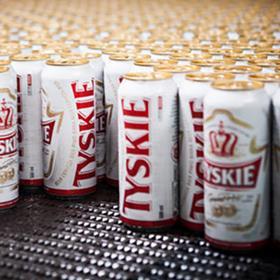
87 (88)
Tyskie
Sales: £36.1m
Growth: –0.6%
Britain’s top Polish beer has sought to maintain its status by offering value for money. It rolled out 4x500ml cans as a £6.79 PMP this March. Tyskie “provides steady sales all year round”, says owner Asahi UK.

88 (81)
Martini
Sales: £34.5m
Growth: –11.4%
Martini has hailed 2025 as a “new era” that will usher in a boom for the “modern aperitivo occasion”. In March, the brand switched to a slimmer, 5% lighter bottle inspired by the arched walkways of Turin.
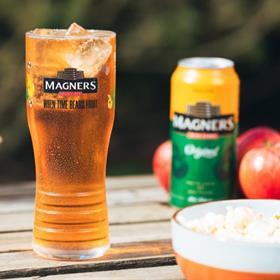
89 (74)
Magners
Sales: £34.4m
Growth: –18.9%
Magners is aiming to find its fizz this summer via the ‘That’s Magnertism’ push. The activity is about “bottling and giving a name to a force and feeling that consumers are already so fond of”, says owner C&C Group.
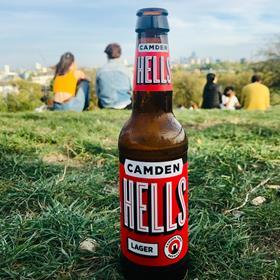
90 (93)
Camden Town
Sales: £32.8m
Growth: +0.2%
Camden Town teamed up with sportswear maker Gilbert to support grassroots rugby in December. They donated beer, balls and discounted access to TNT Sports to local rugby clubs across the UK.
91 (89)
Lanson
Sales: £32.5m
Growth: –7.9%
Lanson, one of the oldest champagne houses, says the UK’s declining champers imports are partly to blame for its 8.9% loss in volumes. Plus, cash-sensitive Brits have cut back on pricier booze.
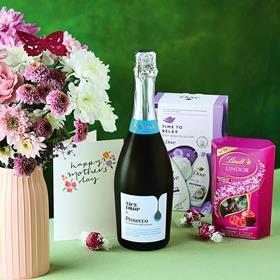
92 (83)
Nice Drop
Sales: £32.0m
Growth: –16.6%
This Asda-exclusive brand is the best value wine in the top 100. So, its £6.4m slump is more likely the result of the supermarket’s travails and loss of market share than Brits reining in spending.
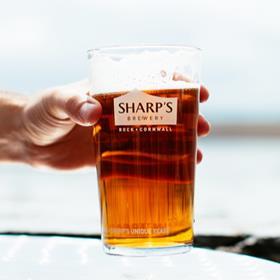
93 (87)
Sharp’s
Sales: £31.9m
Growth: –14.5%
A “challenging” year for the ale category has seen Sharp’s lose £5.4m on volumes down 15.2%. Even so, Doom Bar has made a “strong recovery” of late, says Sharp’s, thanks to distribution gains and promotional activity.

94 (97)
Greene King
Sales: £31.3m
Growth: +4.8%
Greene King’s long-term goal is to lead the premium ale category, says grocery lead Jemma Wiliams. This spring, the brand launched Double Header, a “bold new single-can craft proposition”.
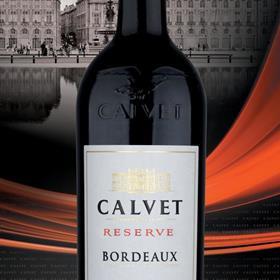
95 (90)
Calvet
Sales: £30.9m
Growth: –10.2%
Calvet has suffered the fifth-biggest volume decline among wine brands. It’s down 12.3%.
Its online series, Calvet Kitchen, returned this month for a fourth season, pairing its wines with dishes made by chefs.
![Old Mout x WWF[4]](https://dmrqkbkq8el9i.cloudfront.net/Pictures/280xAny/8/6/9/362869_oldmoutxwwf4_73272_crop.jpg)
96 (102)
Old Mout
Sales: £30.2m
Growth: +5.7%
Old Mout has turned around its fortunes after last year’s value decline. Owner Heineken UK says growth was driven in part by investment in its ‘Moutopia’ push and its first NPD in three years: Mango & Passionfruit.

97 (103)
Oxford Landing
Sales: £30.0m
Growth: +5.2%
With volumes up 7.7%, Oxford Landing says it’s bucked the “slow decline of the UK wine market”. It teamed up with rugby star Jamie Roberts in February to publicise its British & Irish Lions partnership.
98 (107)
Jura
Sales: £29.6m
Growth: +6.8%
A blend of changing consumer preferences, tax hikes and tariffs means many scotch whiskies have struggled to carve out significant growth in the past year. But not Jura. It’s grown volumes 11.6%.
Distilled on the Scottish island of Jura in the Inner Hebrides, the single malt underwent a major rebrand in 2018, adding a smokier, sweeter core range designed for a younger palate. That positioning has clearly helped the brand weather the current storm in whisky.

“It is eight years since we started on the journey to rejuvenate Jura,” says Kieran Healey-Ryder, head of whisky discovery at brand owner Whyte & Mackay.
“We were fortunate at that time to have an established footprint in Europe, yet we saw an opportunity for this to become a true category leader.
“Jura has welcomed new consumers to the category due to that clarity of purpose, and the accessible style of our whisky – fruity, balanced, and delicious.”
That success is epitomised by Jura Bourbon Cask, a tipple billed as “fresh and fruity single malt whisky with flavours of vanilla, toffee and apricot”. It drew ahead of Jura’s 10-year-old variant this year to become the brand’s bestseller.
It’s worth an extra £4.7m – enough to offset smaller declines across the rest of the Jura portfolio.
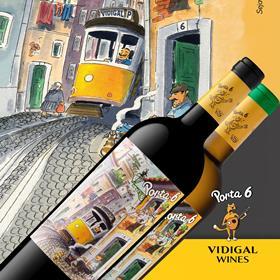
99 (99)
Porta 6
Sales: £29.5m
Growth: +0.8%
Portuguese wine brand Porta 6 has taken a modest 1.8% hit to volumes. It added a bottle of Winemaker’s Selection White Wine last summer and a 1.5-litre bag-in-box format for its Lisboa Red in October.
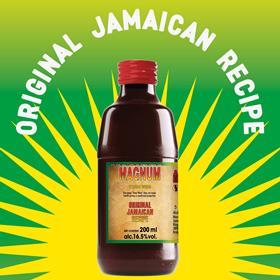
100 (113)
Magnum
Sales: £29.3m
Growth: +11.4%
This Jamaican tonic wine brand – a less heralded part of the Campari Group portfolio – has grown litres by 7.7%. This March, its packaging was updated to ensure it aligned in its key UK and Jamaica markets.



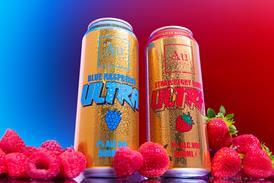

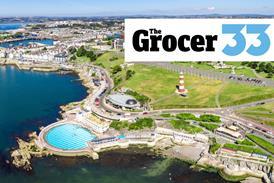
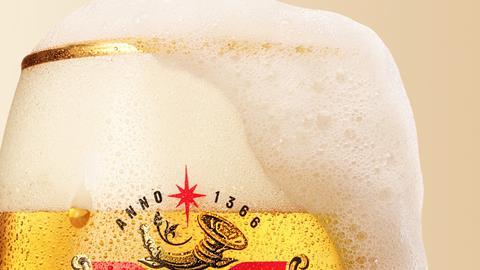

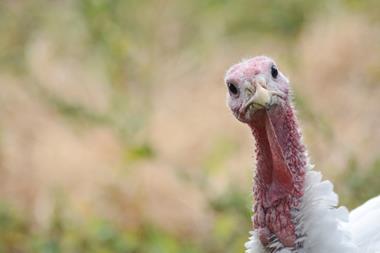

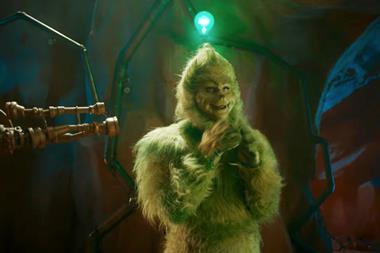




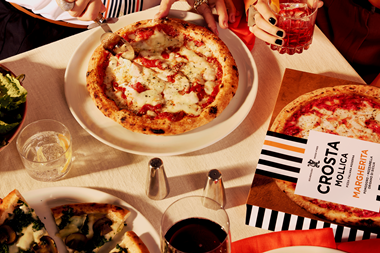

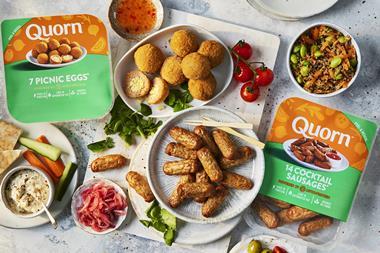
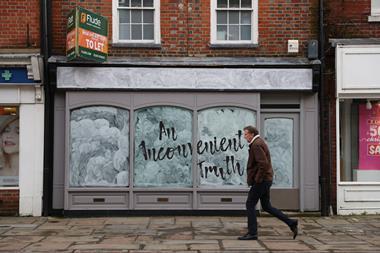
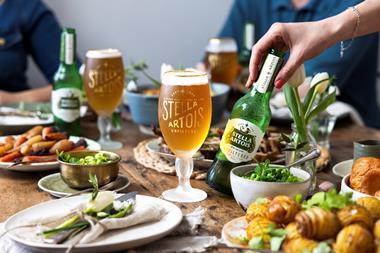
No comments yet